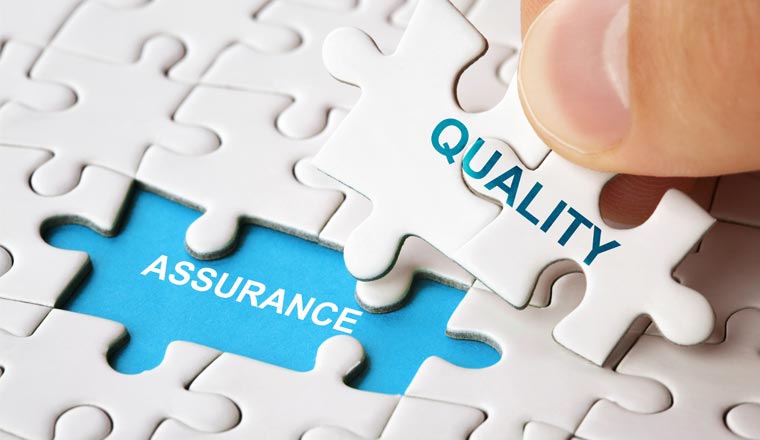Quality assurance, in its broadest form, can be defined as the set of actions that companies take to provide goods and services to consumers with the expected level of quality.
The application of a quality assurance system generates confidence and assurance for companies that their products will meet the expected quality standards.
Therefore, to this end, they apply quality standards as part of a system that enables the development, direction, and control of the entire process.
It can also be said that managed software testing services are an audit that verifies quality standards are met, which means it checks that all the minimum requirements expected in the product are met.
Secondly, for companies to comply with quality assurance, they must follow a line of actions that have been previously planned, systematized, and finally implemented in the form of a set of standards that the company must adhere to.
However, quality assurance requires that all processes be documented, including planning, determining tasks and responsibilities, recording results, and all control mechanisms that are applied within each company.
READ ALSO: A Beginner’s Guide to System Optimization
Table of Contents
How Quality Assurance Was Born?
In fact, quality assurance first appeared as an important element of companies’ production operations during the 1920s.
Since then, Walter Shewhart, one of the first to develop control charts, has been considered the initiator of this system. The same applies to Harold Dodge, who developed sampling techniques, and George Edwards, whose contributions to economic analysis techniques helped solve problems.
Thus, these three characters formulated new inspection methods and theories focused on maintaining and improving quality, which they did when they were transferred from Western Electric’s inspection service to Bell Telephone Laboratories. These contributions are considered the foundation of what is known as quality assurance.
READ ALSO: 11 Thrifty Reasons Why Mobile Automation Testing Is Needed
What Benefits Of Quality Assurance Can You Get?
1. Avoid waste and reduce costs
On the one hand, avoiding the appearance of waste is achieved because the insurance system improves the company’s productivity, as it allows it to better focus on achieving the objectives and what customers expect from the quality of the product.
In addition, waste can be reduced or disposed of because it is possible to identify activities that only increase costs and do not add value to the process, in the same way as it promotes the achievement of efficiency.
2. Improved quality and customer satisfaction
Similarly, continuous improvement enables the delivery of higher-quality products to customers, providing the necessary confidence that the desired quality is achieved and maintained, as everything is documented and certified.
As a result, the company will attract satisfied customers, which encourages them to increase their purchasing frequency and recommend the products to others, generating higher sales revenues and, of course, higher profits.
READ ALSO: Test Automation: Features, Benefits, And Challenges Of Automated Testing
Components Of The Quality Assurance System
The quality assurance system includes the following elements:
1. Administration Manual
Of course, a project management manual includes important data that must be taken into account to be used in each company’s quality management plan, so specific procedures are defined to achieve objectives in a specific way for each organization, usually with the help of a quality management software.
2. Quality control measures
Of course, quality control measures establish the degree or level of quality achieved in each activity evaluated as part of the process. Be able to use criteria such as performance within the set deadlines, compliance with the execution of budgets, and the frequency of errors or defects in the process, among others that could be mentioned.
READ ALSO: Top Features to Look for in Quality Assurance Software for Your Contact Center
3. Reports on the performance obtained
On the other hand, reports on the performance achieved must be prepared periodically throughout the development of the project’s different parts, as this will monitor how all activities are carried out and help avoid higher costs if only the final process is inspected.
Above all, it is possible to assess whether deadlines are met, based on the schedules already prepared, the progress of the delivery process, technical performance, and any activity that involves costs.
READ ALSO: How to Choose the Best Software Development Company in the USA
Quality Assurance: FAQs
Quality Assurance (QA) is a crucial process that ensures a product or service meets the desired standards for functionality, usability, and overall excellence. Here are some commonly asked questions about QA:
What is the difference between Quality Assurance (QA) and Quality Control (QC)?
- QA focuses on preventing defects by establishing processes and procedures throughout the development lifecycle. It’s proactive and ensures quality is built into the product from the beginning.
- QC focuses on detecting defects through testing and inspections. It’s reactive and identifies issues that require attention and correction.
What are the benefits of implementing Quality Assurance?
- Reduced costs: Catching defects early in development is cheaper than fixing them later.
- Improved product quality: QA helps ensure your product meets customer expectations and functions as intended.
- Enhanced customer satisfaction: High-quality products lead to happier customers.
- Increased efficiency: QA helps streamline development processes and avoid rework.
- Improved brand reputation: Delivering quality products strengthens your brand image.
What are the different types of Quality Assurance activities?
- Requirements gathering and analysis: Ensuring clear and well-defined product requirements.
- Test planning and execution: Creating and running tests to identify bugs and ensure functionality.
- Defect tracking and management: Logging, reporting, and resolving identified issues.
- Risk management: Identifying potential risks and implementing strategies to mitigate them.
- Audits and reviews: Evaluating processes and procedures to ensure effectiveness.
Who is involved in Quality Assurance?
QA can involve various roles depending on the organization:
- QA Testers: Execute tests and identify defects.
- QA Analysts: Design and develop test plans and strategies.
- Software Developers: Work closely with QA to fix identified bugs.
- Project Managers: Ensure QA activities are integrated into the development process.
What are some common QA tools and methodologies?
- Testing frameworks: Provide structure and automation for test execution (e.g., Selenium, Cypress).
- Bug tracking systems: Facilitate reporting, tracking, and managing defects (e.g., Jira, Bugzilla).
- Version control systems: Track changes and manage different versions of the product (e.g., Git).
- Agile methodologies: Promote iterative development with continuous testing and feedback (e.g., Scrum, Kanban).
How can I get started with Quality Assurance?
There are several ways to get involved in QA:
- Online courses and certifications: Many resources offer training and certifications in QA methodologies and tools.
- QA internships: Gain practical experience by participating in internship programs.
- Start by testing your own software: Develop critical thinking and problem-solving skills by testing applications you use daily.
A Final Word
In conclusion, we can say that qa as a service brings many benefits to companies, especially in terms of reducing costs, delivering products of the expected quality, and, above all, satisfying their customers.
Since this system enables the documentation of processes to maintain the delivery of products and services at the expected quality, it must be constantly reviewed and updated periodically, as continuous improvement is always sought.
INTERESTING POSTS
- Top Cybersecurity Trends Every Web Developer Should Expect
- 4 Ways That CNC Machining Has Changed Our World
- Breachers Gonna Breach: Protect Your Organization From Internal Threats
- What Are The VPN Features And Benefits?
- 9 Things That Every Gamer Should Have For Seamless Online Gaming
- What Are The Best Practices For Internet Customer Support?
- 6 Smart Ways Web Developers Can Impact Climate Actions
- AI Revolution: Protecting Your Cyber Future
About the Author:
Fiorella Salazar is a cybersecurity expert, digital privacy advocate, and VPN evangelist based in Canada. She holds an M.Sc. in Cybersecurity from a Canadian university. She is an avid researcher and frequent contributor to several cybersecurity journals and magazines. Her mission is to raise awareness about the importance of digital privacy and the benefits of using a VPN. She is the go-to source for reliable, up-to-date information on VPNs and digital privacy.
Meet Angela Daniel, an esteemed cybersecurity expert and the Associate Editor at SecureBlitz. With a profound understanding of the digital security landscape, Angela is dedicated to sharing her wealth of knowledge with readers. Her insightful articles delve into the intricacies of cybersecurity, offering a beacon of understanding in the ever-evolving realm of online safety.
Angela's expertise is grounded in a passion for staying at the forefront of emerging threats and protective measures. Her commitment to empowering individuals and organizations with the tools and insights to safeguard their digital presence is unwavering.










